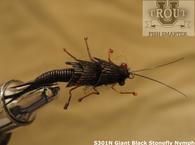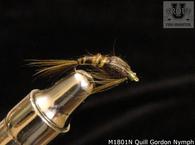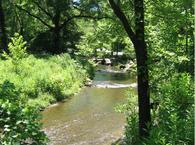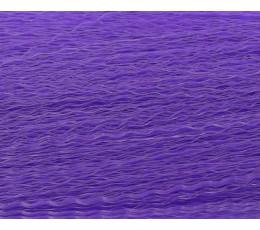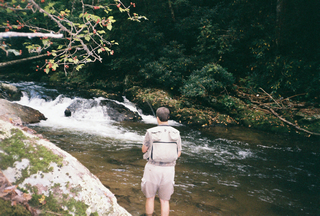
In this class the student will build on his knowledge of streams by learning about the different aspects of pools, from the head of pools to the most complex areas of the pool. Upon completion the sthe student is expected to be able to read pools and know the best spot to launch the fly.
The Head of the Pool — An Easy Spot for Prospecting
Often the water is too deep for you to pick out individual rocks, or the rocks are too small to be differentiated from the characteristic marks on the surface. Even though trout will key in on certain rocks no bigger than themselves, and fish will lie on top of or just behind certain rocks year after year, no one has come up with a formula for predicting what rocks offer exactly the right hydraulics. I hope they never do. When you can't locate the rocks, you have to use other clues. The head of a pool or run is the first place I go, because the water there is faster than in the rest of the pool, so the fish will be easier to approach and fool. (I never told you we would always force ourselves to do this the hard way, did I?) Water coming into a pool, right in the tongue as it spills over whatever obstruction forms the head of the pool, may often be too fast to hold trout. Without a log or rock to block the current's force, this part of a pool may be sterile. Usually, though, as the current entering a pool starts to flatten and slow (typically just below the standing waves, if there are any), there will be a shelf, with an area of calm water below its lip. Here trout can hold in comfort and have the pick of the current. If you can tell me how to get to them in early spring, when there are four feet of raging current above them, then you should be writing this book instead of me. Once in a while, if you twist enough lead in front of a streamer, toss it above the pool, and strip just as it drops over the lip, you might draw one out of the maelstrom. But in the early season the water generally is too cold for a trout to chase anything moving faster than a crawl, so you're out of luck anyway. You can try those guys under the waterfall in midsummer, when the current barely whispers over their heads. There are easier places at the head of the pool.

Turbulence is what makes the head of a pool easier to fish. At the tail of a pool, and usually in the middle, the water velocity is stratified: faster water is at the top, where your fly enters, and much slower water is near the bottom, where the trout lie. When you cast a dry fly upstream in the tail of a pool, the water closest to you is accelerating before it dumps over into the next pool or riffle, so drag sets in almost as soon as your fly lands, making it move unnaturally.

When you cast a nymph upstream, it starts to sink, but the leader and line on top of the water are moving faster, so they begin to pull the fly upward, keeping it out of the productive water below and, again, dragging unnaturally. Your choices include dumping a lot of slack into the cast when fishing a dry or nymph upstream, using a technique that is independent of the current, such as a streamer, or using a technique that uses current to your advantage, like a swung wet fly or a skating caddis. If you're unfamiliar with these techniques, don't worry; I'll describe them in later chapters.
At the head of a pool or riffle, though, turbulence mixes the currents so they're much less stratified. The downstream progress of the water is impeded, making it easier to slip a nymph through the currents or to get a drag-free float with a dry fly. And you can still swing a streamer or wet fly through these currents, so your options are doubled.
Riffles and Soft Spots

Plain, boring old riffles are some of the easiest and most productive places to blind-fish, because the way the water moves conspires against the trout. Current speeds seem uniform both vertically and horizontally: the many cells of turbulence are so small that they produce, for practical purposes, a uniform body of water, lessening drag on a dry fly or a nymph. Contrast a riffle, with its many tiny goose bumps of turbulence showing on the surface, to a boiling slick, where the turbulence cells are larger, big enough to grab your leader and wrench your fly. In a boiling slick the turbulence may even be strong enough to push a trout out of position constantly. Since trout like predictability, if they have to fight for position or they can't accurately take a piece of food, they'll move in a hurry. Unless I'm streamer fishing or I have seen a decent trout rising in them (which is seldom), I avoid boiling slicks like a bank full of worm fishermen.
Datus Proper, in his thought-provoking and iconoclastic book What the Trout Said, describes places he calls "soft spots." These are places where almost anything you do will produce a strike — places that Proper takes rank beginners to bolster their confidence. Every stream I fish has some soft spots, which I have found through experience, and I use them for special guests, children, and impatient or discouraged fishing buddies. All of the soft spots I know are in gentle riffles, lacking either strong whorls of current or the rooster tails of standing waves.

A wide expanse of riffle, whether at the head of a pool or in a transition between pools, seems at first to have no features. Look harder. First you'll notice seams at the edge of the riffle, and these are worth much of your time and effort. Out in the middle of the riffle, look for slicks — areas that look as though someone polished and flattened the bumps on the surface. Slicks are formed either when the water is too deep for the turbulence formed by contact with the bottom to reach the surface, or when the water is slowed by a plateau in the streambed or an object on the bottom. If there is enough water, all of these places will hold trout. Depth is a limiting factor for trout abundance only when the water is so shallow that trout feel insecure about holding in it. In a riffle the water may be too shallow to hold adult trout, because as a rule they need to have a foot of water over their backs and a nearby refuge. So look for the places where the water is too deep for you to see the stones on the bottom clearly; when looking at slicks, make sure they are big enough or deep enough that a trout can find a place to hide when you stumble up through the currents. A slick the size of a kitchen sink in the center of a shallow riffle might offer all the food and protection from fast currents a trout needs, but a trout won't stay alive there for long unless the merganser population has flown south for the winter.
If you can find a slick the size of a bathtub with secure cover nearby, you may find a trout that everyone else has missed. I remember one place in a shallow riffle I must have walked through fifty times without a cast. There was an old dead tree trailing in the riffle, and at the downstream end was a tiny pocket, barely deep enough to cover my ankles. I stared and thought I could see bare stream bottom, but I cast a Gray Fox Variant anyway. A brown shape formed seemingly out of the gravel, rose to meet the fly, moved without apparent haste to the tangle of branches, and broke my leader. I have been back to the same place another fifty times and have not seen that trout again.
The Middle of the Pool
The middle of a pool also often looks featureless, without the obvious seams between fast and slow water that guide you to trout at the head. If there is nothing else to guide me, I can find the best fish in the middle of a pool by tracing the main threads of current down through it. Look up to the head and follow the line of bubbles and debris carried by the current, and you'll see the best feeding positions. Even if the places where the main current flows are shallower or offer less cover than water off to the side, you'll find more trout, and especially more feeding trout, where the current brings a constant stream of food.

Look on the bottom for lines of color that show a dramatic change in depth. Trout may hide in the dark depths when you stumble through a pool, but deep water doesn't offer much food. If the depth suddenly changes from eight feet to two feet, all the food being carried by the current is forced into a narrow vertical choke point, and a trout here can see all the food that the current carries. In the bottom of a hole he can see only a fraction of it. Look too for rubble on the bottom, as opposed to sand or gravel. The rougher the bottom, the greater the number of nooks and crannies that offer places to hide and pockets of slower water, energy-efficient places for a trout to live and feed. If the water isn't too slow or too shallow, you'll be able to spot these places if you can't "see" into the water by reading the roughness of the surface.
The Most Difficult Part of a Pool

Everything I've said about rocks and banks and logs applies to the tail of a pool as well, and in most of the rivers I've fished, the tails hold the largest trout. All the food passing through a pool is channeled at the tail into a vertically and horizontally constricted funnel, and the smooth water here allows a nearly unobstructed view of the outside world, which warns of the approach of all kinds of predators. During a hatch the tail of a pool is the first place I'll go to catch a trout that will pull line off my reel. It is also the last place I'll go to prospect. When a trout in the tail of a pool is preoccupied with feeding and you know exactly where he is, approaching him is still difficult; when he is not actively feeding, it is masochistic. Because the tail of a pool is shallower than the middle, look for the deepest place in the tail to hold the most trout, barring any rocks or logs in the water. The place where the tail begins to shallow, where dark water gives way to lighter-colored water, will often be where trout are lined up to feed. If the water close to the banks is deeper than in the middle, and especially when vegetation meets the water, you'll often find more and bigger trout next to the banks than out in the middle.

When you stand at the tail of a pool and fish upstream, following the usual line of attack, the water at your feet is faster than the water you cast into. The water in the tail is always accelerating, particularly in the early season when the current is faster. As soon as your fly lands, drag sets in, and even throwing big piles of slack will not always counteract this problem. You can get a better presentation by casting from upstream or from across-stream and throwing upstream curves, and this works best early in the season when you can get closer to the trout without spooking them. In midsummer I find that from above you spook the fish in the tails of most pools, especially in smaller streams or when the water is unusually low.
Because most aquatic insects live in riffles, and everything that hatches in a pool that doesn't fly away will be funneled into the tail (as will any terrestrial insect that falls into the water), trout in the tail of a pool seem more aware of surface food than trout in any other place. If you stand and watch long enough, you will often see them sipping here throughout the day, especially in the low water of late season. This is not really a hatch situation; it is opportunistic surface feeding at every little morsel that drifts by. Sometimes you can watch for twenty minutes before you see a rise, so if you're moving at a normal pace you won't spot the fish, and you'll fish the tail blind. During the summer, when the current has slowed enough, you can often make a short, accurate upstream presentation from a trout's blind spot. But since your drift will still be short before it drags, decide first where you think the trout will be lying — don't just blast away at random. It's a good idea to study the surface currents for several minutes as well. If you can get close enough to where you think a trout might be, and you can figure an angle from which you can get a drag-free float, a terrestrial pattern or small spinner imitation in the middle of the day may rise a trout of a size you would normally see only during the evening hatch.
Even in the same stream at the same time of year, you cannot approach the tail of a pool with the casual tactics that might work in a riffle. If you want to catch trout in the tails of pools, study the last chapter on approach carefully. In the technique chapters that follow, note these techniques that have worked best for me in the tails of pools: actively stripped streamers, swung wets, and skated dry flies. Exerpts from The Orvis Guide to Prospecting for Trout. by Tom Rosenbauer
Put on some polarized sun glasses and explore some of your favorite streams, concentrating on the pools. Oserving the trout and studying their habits.
Recommended DVDs:
Fly Fishing for Trout in Tailwaters
Fly Fishing Strategies That Catch Trout
Read the The Orvis Guide to Prospecting for Trout.
Note: Class material has appeared in MidCurrents.


